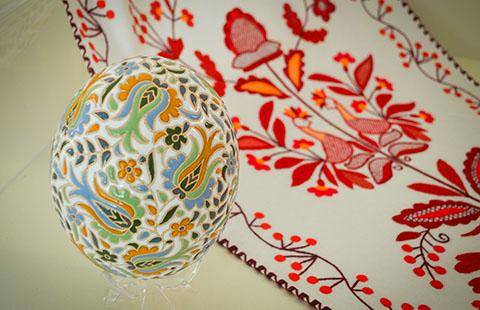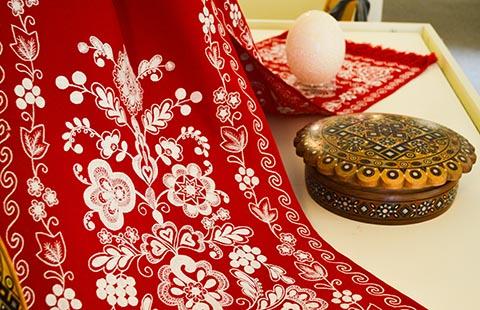Ukrainian Folk Art Exhibit Continues Through Spring
“Ukrainian Folk Art Traditions: Preserving Cultural Identity” will remain on display in Dimond Library throughout the spring semester. This absorbing exhibit features a range of artworks including paintings, ceramics, textiles, woodworks and pysanky (traditional Ukrainian eggs decorated with a batik technique). Ukrainian identity is preserved and encoded in these items and the traditions they represent, which speak to the vibrant heritage and unbowed spirit of the free people of Ukraine.

Ukrainian folk art is rich in symbolism that has been handed down from one generation to the next, with some patterns dating back as far as the Neolithic era’s Trypillian culture. Several of the traditions on display—including Petrykivka painting, Hutsul painted ceramics, Crimean-Tatar ceramics, and pysanky—are included in UNESCO’s Representative List of the Intangible Cultural Heritage of Humanity. Pysanky became the most recent addition to the UNESCO list in December 2024.
And every piece in the exhibit serves as a testament to the determination of artists whose work, like so much else, is threatened by war. Tetyana Konoval, a pysanka artist, has said she would not be able to create if she were to leave Ukraine, as culture and folk art are an intertwined part of terroir, the natural environment in which her work is made. Despite the danger, says the Crimean-Tatar artist Rustem Skybin (translated by Sophia Sushailo), “Ukraine continues to stoically fight for its right to exist, defending its core democratic values: its right of self-identity as a nation and a country, its right of freedom, free expression of ideas and opinions, and free choice.”
“Our world rests on the pillars of wisdom, dignity, justice and honor, encoded by our ancestors,” continues Skybin. “On the one hand, all of this is so fragile, and on the other hand, it is so incredibly robust, like an egg. For me, the egg became a symbol of our world. Fragility bears power, which creates hope for a happy future. It gives birth to new life, new generation, new values, and therefore—it gives birth to a new nation.”

The symbolism of the egg is prominent in “Ukrainian Folk Art Traditions: Preserving Cultural Identity,” as examples of pysanky and other decorated eggs are included in the exhibit. Some historians date the pysanky tradition to Paleolithic times, when pysankas were made of stone, clay or bone; a modern pysanka might use traditional symbols and transgenerational techniques to display artistic interpretations of the current moment. In this way, with every new pysanka, the ancient and the modern intertwine.
The UNH Library hosted a free pysanky workshop for the public in November 2024, led by artist and teacher Christina Vogel. Due to the popularity of this first installment, a second pysanky workshop is planned for spring 2025. Interested participants can follow the UNH Library on Facebook, Instagram or LinkedIn for further updates, or reach out to Digital Collections Coordinator, Sarah Stinson.
All UNH Library exhibits are open to the public at no cost during regular library hours.
The items in “Ukrainian Folk Art Traditions: Preserving Cultural Identity” are on loan from the collection of Sophia Sushailo and Maxime Guinel de France.